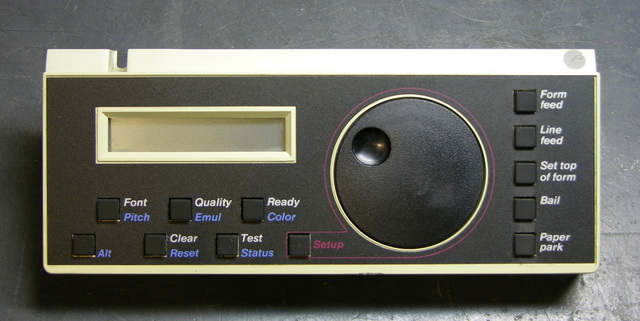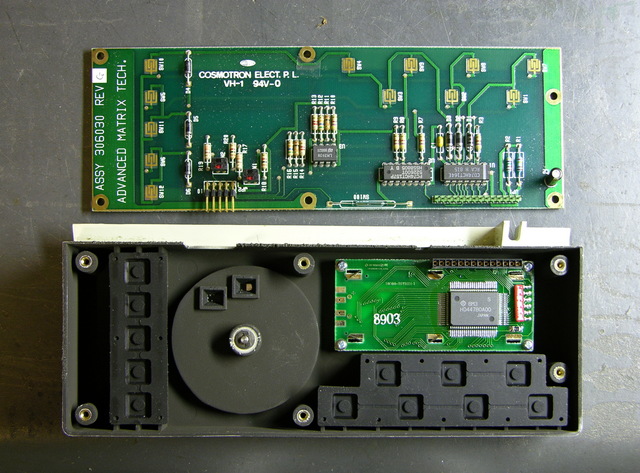At my first “real” job, among other things, I maintained a fleet of AMT Accel-500 wide-carriage printers. Thus it was that in 1990 I was introduced to my first “spinny wheel” user interface.
The printers had a wide range of configuration options, from serial port settings to fonts to paper-advance behavior. All were controlled through this panel, by entering configuration mode, spinning the wheel to select an option, entering change mode, and spinning the wheel to select the value.
As much as I hated certain things about the printers (particularly their declining paper-feed reliability as they aged), I was absolutely enamored of their user interface. For that and other reasons, when my employer finally converted all office printing to laser and retired all the Accel impact printers, I took them home. Thirty-plus of them. Stacked them in two tall stacks in storage, where they still sit.
It’s from those printers that I got the stepper motors I’m using in my CNC project, and I’ve recently cannibalized one for other potential CNC parts. But for whatever reason, although I’ve dreamed over the years of using the spinny wheels in my own user interfaces (custom car MP3 player, etc.), I’ve never opened one to see what was inside. Until tonight.
I’ve received my smaller LCD screens and I’m back to work on the LED calculator, with everything pretty much settled except the means of selecting target circuit voltage. I’d really like to use a rotary encoder, and I’ve found a couple of choices that I can order from Digi-Key; but I really wanted to prototype one tonight. Thus at last I turned to my trusty printer’s control panel, hoping to find a smooth-as-silk mechanical rotary encoder underneath that lovely, lovely wheel.
Feh.
It’s optical, with alternating silver and black sectors on the back side of the disk, and optoreflectors that tuck into recesses in the wheel’s housing.
Bleah, bleah, bleah. I definitely don’t want to deal with optoreflector interfacing tonight, and I really didn’t want to in my hypothetical other projects either. Furthermore, the housing is pretty custom to the wheel and would have to be duplicated or Frankensteined into another enclosure (“Frankenclosure”?), rather than just popping the wheel onto a rotary encoder’s shaft outside the case.
Dear me.


I hate to point this out, but the chips appear to be fairly standard, as is the LCD, you could always reverse engineer the board (it looks rather simple) and just use the existing connector and LCD. All you’d have to then would be to make a sticker to go on the front and find a box to go on the back.
Of course, this doesn’t solve the optoreflector interfacing problem as it appears that it’s done on the board that connects to this.
I like the reed switch, by the way. What did it do?
Julian — yeah, the LCD looks standard and the pushbuttons would be easy to reverse-engineer, but I wasn’t so much after the whole panel as just the spinner. And I’m too lazy to deal with the optoreflector interfacing right now.
The reed switch was to halt the printer when the cover was opened. (Nice job spotting that in the photo.)
You can thank bunnie for that, his “name that ware” contest really makes on open one’s eyes to the components on a circuitboard. (Oh the things I’ve picked out of dumpsters because I’ve seen that they have relatively standard or interesting components, I really need to put something on my blog about that)
I see your point though: for the projects you mentioned, you wouldn’t need *12* buttons and the hassle of the encoder decoding. But it’s a thought. =)
Hmm, I wonder if you could hook it up to a PS2 mouse’s innards…
Hey Keith. Good to see you’re back to hacking. I think the little control panel has potential. You could rip off the overlay and print up something custom for controlling a stepper motor CNC axis. Make 3 of them for X,Y,and Z. The LCD could show the position. But if you’re sick of looking at them for so many years, I understand.
Tom, definitely thinking about that already. The three buttons under the LCD could be XYZ, and the four below that could be 1/10/100/1000 steps per “click” of the wheel. Great for positioning the CNC drill/cutter for alignment before beginning a run.
I’d say reverse engineer it too! That would make a great CNC jog controller.
I’m pretty ignorant about electronics (really ignorant, actually) but I have found that interfacing CNC software with optical encoders isn’t all that difficult even for someone like me. Maybe it’s just the uses I’ve put them to or the types of opto I’ve run into. It might be dumb luck, but I haven’t had any trouble yet. There are also already some inexpensive boards out there designed simply to interface opto switches for this function, as well as limit switches, into some of the unused signal lines on your parallel port to use as inputs to trigger motion through the controller software you are already using to run your drivers. I know Mach3 is set up to interpret quadrature encoders directly already, don’t know about any other software. I think all you have to do is feed it the two signals and let it suss it out, don’t think you need to design any interface logic.
I’m going way out here as it’s been awhile since I screwed with drive interface, but I think when I did it I just powered the opto sides, and ran what I think you would call sinking inputs(?) from two parallel signal pins to pins 18-25 (gnd), and told the software what the encoder pins were in the supplied config menu. Hope that doesn’t sound stupid, I just build the CNC machines themselves, I really don’t know much about this electronics side of things and although I tried at one point I just leave that part of it to others now!
That being said, if you want to send me one of those I’ll certainly try to get one going as a jog controller and send you the instructions on how I did it if you don’t want to have a crack at it yourself!
Eric, I probably will reverse-engineer it at some point, to include in the CNC machine I’m (slowly) building. I think you’re right that if I trace out the optosensor connections, I’ll be able to connect it to a microcontroller fairly easily.
My reluctance to reverse-engineer it at the time had to do with being in a hurry to get a rotary encoder that I could pop into another circuit. I had hoped for a mechanical encoder that I could desolder and use on a breadboard, and this clearly wasn’t going to be that simple, that fast.
When I do reverse-engineer one, including the LCD, I’ll definitely write it up.
Hy buddy nice to hear that you are fermiliar with this printer. I was given one and wanted to use it for printing out invoices and so on about 100 a monthe and also to print statements. My question is, when i do a test print withe the printers front pannel, it prints realy fast but when i print from Windows on any of the emulators it prints slow. how can i solve this problem
Adaan, I’ve never used one with a Window machine. However, one thing that comes to mind is that the ones I maintained were serial printers, and you may want to increase your baud rate.
Note that a higher baud rate will cause print errors if you don’t have hardware and/or software handshaking configured correctly.
I still have one of these and agree-with age their paper feed reliability decreased. The push/pull tractors work fine, but no friction feed when that belt finally dries out and breaks.
I always loved using this printer and we really beat the daylights out of that printhead back in the day–yet it never failed then and still works now!
Do you, by chance, know if replacement belts are available and if so, where? Although I’ve replaced it with another for everyday use, I kinda of a nut about keeping legacy equipment in working order if possible.
Thanks in advance…
Houlihan, when I was maintaining these, I only ever bought parts from AMT. You could probably measure the belt and find a replacement at McMaster-Carr, though — they have everything!